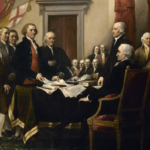Picture this: a shadowy group, concealed by hoods, spreading hate and division across America for centuries. That’s the Ku Klux Klan, and their game is called ethnocentrism – the belief that their way is the only right way. It’s a dangerous belief that’s poisoned our nation’s history and keeps rearing its ugly head today. Let’s dive into the dark depths of the KKK’s ethnocentrism, explore its origins, how it manifests in our world, and why it’s still a threat we need to watch out for.
Unmasking the Klan: Understanding Their Ethnocentric Beliefs
The Ku Klux Klan (KKK) is a name synonymous with hate. But what exactly fueled their reign of terror? It all boils down to a dangerous idea called ethnocentrism – the belief that your own group is superior to everyone else. For the Klan, this meant white, Anglo-Saxon Protestants were inherently better, and everyone else, especially African Americans, were inferior and a threat. This belief was at the dark heart of the Klan’s actions, justifying their violence and intimidation.
Imagine living in the Reconstruction era, just after the Civil War. African Americans, newly freed from slavery, dared to dream of equality and a voice in government. The Klan, threatened by this change, sought to crush these aspirations. Their methods were brutal: lynchings, bombings, intimidation – all designed to keep Black Americans powerless and afraid. They weren’t just hateful individuals; they were a terrifying force shaping the very fabric of society.
Do you want to see the emmett till death photos that shook the world and sparked the Civil Rights Movement?
But the Klan’s hate wasn’t limited to African Americans. As the decades passed, their list of “undesirables” grew. In the 1900s, they set their sights on immigrants and Catholics. They held massive rallies, spread propaganda, and used social pressure, all with the goal of reinforcing their twisted worldview and turning their neighbors against anyone deemed “different.”
Why this deep-seated prejudice? Some experts suggest complex factors were at play. Economic anxieties likely played a role; poor whites, struggling to survive, were easy targets for the Klan’s message, which often blamed their hardships on minorities. This fear of losing their already precarious status probably fueled resentment and, tragically, violence.
Religion, a powerful force, was also twisted to serve the Klan’s agenda. They hid behind distorted Christian symbols, using them to justify their hateful actions and give themselves an air of legitimacy. This manipulation of faith added another layer of complexity to their ideology.
The Klan’s legacy, unfortunately, isn’t confined to the history books. Their poisonous ideology contributed to the systemic racism that continues to plague America. The effects of segregation, discrimination in housing, education, and even our justice system – these are all rooted in the very same ethnocentric beliefs the Klan espoused.
You won’t believe the story of the clergyman who hobnobbed with the founding fathers.
Even today, hate groups exist, drawing inspiration from the Klan’s playbook, a stark reminder that the fight against prejudice is far from over. This continued presence highlights the need for constant vigilance and education to combat hate in all its forms.
So, what can we do? Knowledge is power; understanding the roots of prejudice helps us recognize and challenge it in ourselves and others. Empathy is key – stepping into the shoes of those who are different, listening to their stories, and understanding their struggles can break down barriers.
Combating hate requires a collective effort. By promoting tolerance, celebrating diversity, and actively challenging prejudice, we can create a world where the Klan’s hateful ideology remains a dark chapter in our past, not a reflection of our future.
How the KKK Used Ethnocentrism to Fuel a Century of Terror
The Ku Klux Klan didn’t rise to power by accident. They skillfully used ethnocentrism – the idea that one’s own group is superior – to spread fear and justify their horrific acts. They warped the idea of pride in one’s heritage into a tool for hate and oppression, turning American against American.
Here’s how they did it:
- Propaganda: Imagine opening a newspaper or hearing a speech that constantly told you that a certain group of people, simply because of their skin color or where they came from, were dangerous, lazy, or un-American. This constant barrage of misinformation created a false “us vs. them” narrative, making some white Americans afraid and distrustful of anyone who wasn’t like them.
- Violence: The Klan didn’t just talk; they used terror to silence anyone who dared to oppose them. Lynchings, where Black Americans were publicly murdered by mobs, were horrifying displays of their power. Cross burnings, symbols of hate and intimidation, were often left on lawns as threats. Bombings of churches and homes instilled fear in entire communities. These acts were calculated to make Black Americans feel powerless and unsafe.
- Voter Suppression: Imagine being denied the right to vote because of the color of your skin. That’s exactly what the KKK wanted. They used threats, violence, and even outright cheating to keep Black Americans away from the polls, making sure their voices weren’t heard. By doing this, they maintained political control and kept the cycle of oppression going.
Did you know that voter fraud tainted the vote on Kansas statehood?
- Economic Oppression: The KKK didn’t want Black Americans to have equal opportunities. They used their influence to deny them good jobs, housing, and education. This kept generations of Black families trapped in poverty and limited their chances for a better future.
The KKK’s reign of terror might be over, but their hateful ideology casts a long shadow. White supremacist groups today still use the KKK’s playbook, twisting history and exploiting fears to push their agenda. Systemic racism – the way racism is built into the very fabric of our society – continues to disadvantage people of color in countless ways.
Here’s what we should take away from this dark chapter in history:
- Recognize and challenge ethnocentrism. It’s easy to think “my way is the right way,” but we need to be aware of how this kind of thinking can be manipulated into something dangerous.
- Be critical thinkers. Question what you see and hear, especially when it reinforces stereotypes or paints entire groups of people in a negative light.
- The fight for equality is far from over. We need to be actively anti-racist, challenging injustice and working to dismantle systemic barriers wherever we find them.
The KKK’s legacy is a stark reminder of what can happen when hate and prejudice go unchecked. But it also serves as a powerful call to action – to learn from the past, confront the present, and build a future where everyone has the opportunity to thrive, regardless of their race or background.
Who Were the Targets of the Klan’s Hate?
The Ku Klux Klan wasn’t content with targeting just one group. Their hate, sadly, spread much wider. If you weren’t white and Protestant, there was a good chance you were in danger.
We’ve already talked about how African Americans were the Klan’s primary victims. This group lived in constant fear of the KKK’s brutality. Lynchings were horrifyingly common. Then there were the bombings and arson attacks – all designed to make Black Americans feel like they were less than human and had no place in society.
But it didn’t stop there. White folks weren’t immune to the Klan’s brand of terror either, especially if they were Republicans. After the Civil War, there were white folks who came down South to help with rebuilding and making things fairer for everyone. These were the “carpetbaggers.” Then you had Southern whites who supported these efforts, the “scalawags.” The Klan saw them as betraying their own race and treated them as badly as they treated Black people.
The horrible truth is that if you stood up to the Klan, no matter who you were, you were putting yourself in harm’s way. Teachers and writers who believed in equality for all, folks who had immigrated from other countries, Catholics, Jews – they all faced the Klan’s wrath. It’s a dark and scary chapter in American history, and it’s crucial that we remember it so that we never repeat it.
Is the KKK’s Ideology Still a Threat Today?
The KKK’s hateful beliefs didn’t just disappear. Even though the KKK itself is much smaller now, similar groups are still around, and they can be just as dangerous. They use the internet and take advantage of problems in society to spread their hateful messages.
Think of it like a weed – you might pull out the main plant, but the roots can stay hidden and sprout new problems later. That’s why it’s important to remember that the harm caused by the KKK isn’t just in the past. Their way of thinking, that one group of people is better than others, is still a problem today.
These groups, often called white supremacists, are like a nasty echo of the KKK, using fear and hate to try and get what they want. They target anyone they see as different, just like the KKK did.
So how do we stop this? It’s going to take more than just hoping it goes away. We need to be proactive:
- Education: We need to teach people about the dangers of thinking one group is superior to another. This kind of education helps build tolerance and understanding between different groups.
- Vigilance: Law enforcement needs to keep an eye on these hate groups and stop them from hurting anyone.
- Community: Strong communities can push back against this kind of hate. When people from different backgrounds connect and build relationships, it makes it harder for hate to take root.
Fighting the KKK’s legacy isn’t just about remembering history; it’s about making sure those same hateful ideas don’t take hold again. It’s a fight for fairness and equality for everyone, and it’s a fight we all need to be a part of.
Combating the KKK’s Legacy: A Call to Action
The Ku Klux Klan’s hateful ideology, centered on the belief that white people are superior to all others, has unfortunately left a lasting scar on America. While their reign of terror might seem like a dark chapter of the past, we can still feel the echoes of their hate today. So how do we combat something so deeply ingrained in our history?
The KKK didn’t just disappear overnight. They’ve had periods of resurgence throughout history, especially when they felt threatened by social progress. Any time equality felt within reach for marginalized communities, groups like the KKK would rise again, using violence and intimidation to maintain their grip on power.
What made their influence even more insidious was their ability to infiltrate places like law enforcement and government. This allowed them to shape laws and policies, further solidifying their power and making it even harder to dismantle their hateful ideology.
It’s important to remember that the KKK and its hateful beliefs are not just relics of the past. The unfortunate reality is that groups espousing these dangerous views still exist today, and their impact can be seen in the rise of white supremacist violence.
So, how do we combat this? It won’t be easy, but there are concrete steps we can take:
- Shine a Light on the Past: We have to understand where we came from to move forward. That means educating everyone, ourselves included, about the KKK’s history, their beliefs, and the devastating impact they’ve had on our country.
- Stronger Laws, Stronger Enforcement: Passing and enforcing laws that punish hate crimes and prevent the spread of hateful ideologies like white supremacy are crucial. These laws should be created with input from the communities most affected by these crimes.
- Equipping Our Protectors: Law enforcement needs proper training to recognize, understand, and effectively address hate crimes and white supremacist activities. This includes understanding the historical context, identifying hate symbols, and learning de-escalation techniques specifically designed for these situations.
- Building Bridges, Building Trust: We need to work towards strong, healthy relationships between law enforcement and communities of color. This starts by actively listening to the concerns of these communities, building trust through transparency and accountability, and working together to find solutions.
- No Room for Hate, Online or Off: We must challenge racist and prejudiced views wherever we encounter them. This means speaking up when you hear a joke that demeans another group, calling out discrimination when you see it, and using our voices to advocate for equality and justice.
- Supporting Those Who Need It Most: Communities targeted by the KKK and other hate groups often need support and resources to heal and rebuild. This can range from providing access to mental health services and legal aid to supporting community organizations that fight for social justice.
Combating the KKK’s legacy isn’t about erasing history. It’s about learning from it, challenging injustice, and working tirelessly to build a society where everyone feels safe, respected, and valued. It’s about understanding that the fight for equality is an ongoing process, and it requires constant vigilance, education, and a commitment to justice for all.
















